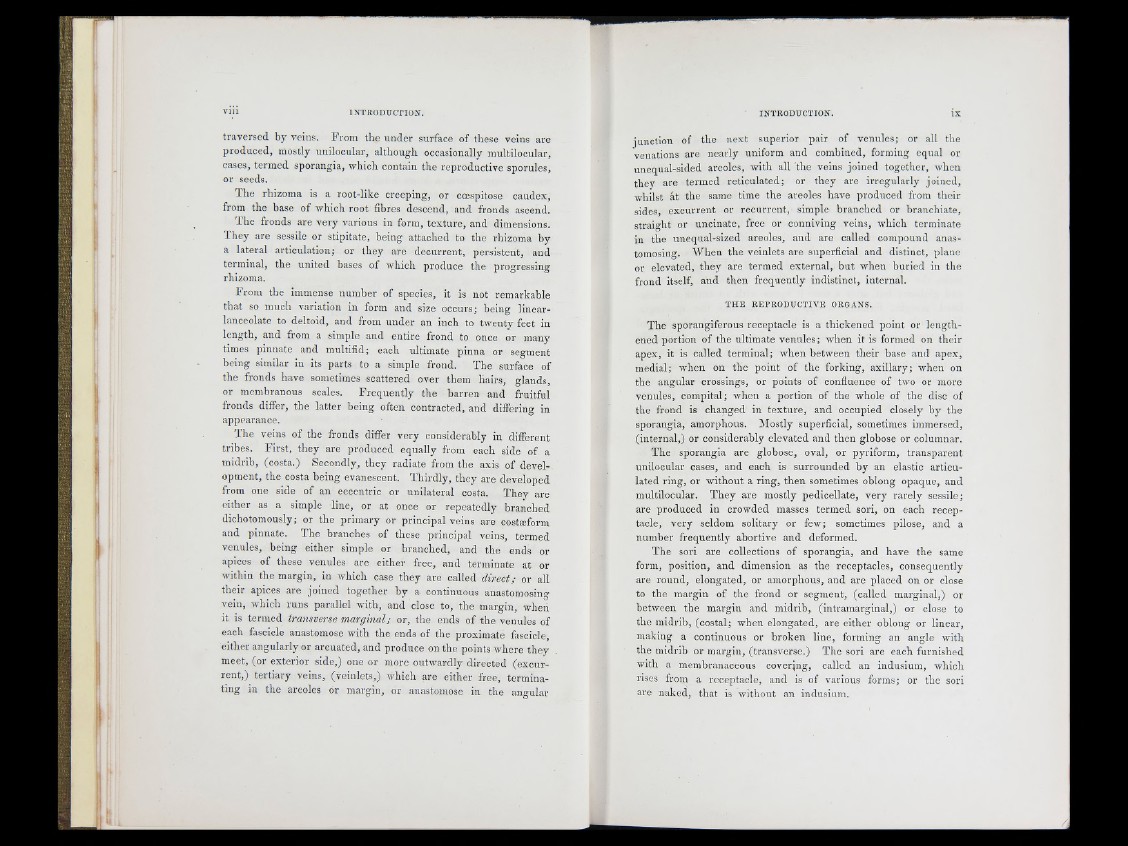
traversed by veins. From the un d e r surface of these veins arc
produced, mostly unilocular, although occasionally multilocular,
cases, termed sporangia, which contain the reproductive sporules,
or seeds.
The rhizoma is a root-like creeping, or coespitose caudex,
from the base of which root fibres descend, and fronds ascend.
The fronds are very various in form, tex tu re , and dimensions.
T hey are sessile or stipitate, being attached to the rhizoma by
a lateral articulation; or they are decurrent, persistent, and
terminal, the u nited bases of which produce the progressing
rhizoma.
From the immense number of species, it is not remarkable
th a t so much variation in form and size occurs; being linear-
lanceolate to deltoid, and from u n d e r an inch to twenty feet in
length, and from a simple and entire frond to once or many
times pinnate and multifid; each ultimate pinna or segment
being similar in its parts to a simple frond. The surface of
the fronds have sometimes scattered over them hairs, glands,
or membranous scales. F req u en tly the b arren and fruitful
fronds differ, the latte r being often contracted, and differing in
appearance.
T h e veins of the fronds differ very considerably in different
tribes. F irs t, they are produced equally from each side of a
midrib, (costa.) Secondly, they radiate from the axis of development,
the costa being evanescent. T h ird ly , they are developed
from one side of an eccentric or unilateral costa. T hey are
either as a simple line, or at once or repeatedly branched
dichotomously; or the prima ry or principal veins are costæform
and pinnate. The branches of these principal veins, termed
venules, being either simple or branched, and the ends or
apices of these venules are either free, and terminate at or
within the margin, in which case they are called dire c t; or all
their apices are joined together by a continuous anastomosing
vein, which runs parallel with, and close to, the margin, when
it is termed transverse marginal; or, the ends of the venules of
each fascicle anastomose with the ends of the proximate fascicle,
either angularly or arcuated, and produce on the points where they
meet, (or exterior side,) one or more outwardly directed (ex cu rren
t,) te rtia ry veins, (veinlets,) which are e ither free, terminating
in the areoles or margin, or anastomose in the angular
junction of the n ext superior pair of venules; or all the
venations are nearly uniform and combined, forming equal or
unequal-sided areoles, with all the veins joined together, when
they are termed re ticulated; or they are irregularly joined,
whilst át the same time the areoles have produced from their
sides, excurrent or recurren t, simple branched or branchiate,
straio-ht or uncinate, free or conniving veins, which terminate
in the uuequal-slzed areoles, and are called compound anastomosing.
W h en the veinlets are superficial and distinct, plane
or elevated, they are termed external, b u t when b uried in the
frond itself, and then frequently indistinct, internal.
T H E R E P R O D U C T IV E O R G A N S .
The sporangiferous receptacle is a thickened point or len g th ened
portion of the ultimate venules ; when it is formed on their
apex, it is called terminal; when between their base and apex,
medial; when on the point of the forking, axillary; when on
the angular crossings, or points of confluence of two or more
venules, compital; when a portion of the whole of the disc of
the frond is changed in tex tu re , and occupied closely by the
sporangia, amorphous. Mostly superficial, sometimes immersed,
(internal,) or considerably elevated and then globose or columnar.
The sporangia are globose, oval, or pyriform, transparent
unilocular cases, and each is surrounded by an elastic a rticulated
ring, or without a rin g , then sometimes oblong opaque, and
multilocular. T hey are mostly pedicellate, very ra re ly sessile;
are produced in crowded masses termed sori, on each receptacle,
very seldom solitary or few; sometimes pilose, and a
number frequently abortive and deformed.
The sori are collections of sporangia, and have the same
form, position, and dimension as the receptacles, consequently
are round, elongated, or amorphous, and are placed on or close
to the margin of the frond or segment, (called marginal,) or
between the margin and midrib, (intramarginal,) or close to
the midrib, (costal; when elongated, are either oblong or linear,
making a continuous or broken line, forming an angle with
the midrib or margin, (transverse.) The sori are each furnished
with a membranaceous coverjng, called an indusium, which
rises from a receptacle, and is of various forms; or the sori
are naked, that is without an indusium.